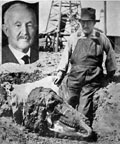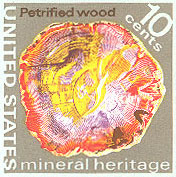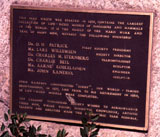Introduction
C.H. Sternberg was a professional fossil collector and amateur paleontologist who discovered many of the greatest vertebrate fossils in North America. Among his sons, George F. eventually became Curator of Museums at Fort Hays State University (Kansas). Charles M. was associated for many years with the National Museum in Ottawa, Canada, and Levi was a member of the Royal Ontario Musuem in Toronto (Canada).
C.H. Sternberg spent the first 15 years of his life near Cooperstown, New York, in the Susquehanna River valley. His father, Rev. Dr. Levi Sternberg, was principal at Hartwick Seminary. Throughout his career Sternberg had strong religious convictions. He had an early love for nature, but at age 10 he fell and dislocated his left fibula. He never fully recovered from this injury and limped for the rest of his life. In 1865 the family moved to Albion, Iowa, where his father had a new teaching position. Two years later Charles H. and his twin brother moved to central Kansas to work on an older brother's ranch. The ranch was located in Ellsworth County, at the western terminus of the Union Pacific railroad, where buffalo herds roamed freely.
At age 17, Sternberg decided to devote his life to the study of fossils and earth history. He wanted to bring the wonders of God's creation to light scientifically through fossils. He made a large collection of fossil leaves from the Dakota Formation of the local area. In 1870 he sent specimens to the Smithsonian for identification, and in 1872 he met Leo Lesquereux, famous paleobotanist, who came to collect in the vicinity. Lesquereux was so impressed by Sternberg, that he named a new fossil plant for him—Protophyllum sternbergii. Sternberg continued to work with Dakota material off and on until 1897. In 1875-76, he studied at Kansas State Agricultural College (now Kansas State University), but apparently without completing a degree. In 1880 he married Anna Reynolds, and they had three sons.
Rock City, Dakota Formation

| Rock City, near Minneapolis, Kansas, displays large concretions in sandstone of the Dakota Formation. Ground view (left) and vertical aerial shot (right); the building roof is about 20 feet (~6 m) long. Photos by S.W. and J.S. Aber
| 
|
Professional fossil hunter
Sternberg's professional career began in 1876, when he attempted to join Mudge's field party that was working for Marsh. There was no room for Sternberg, so he wrote to Cope and offered his services. Cope sent $300 to collect fossils. Marsh and Cope were bitter rivals in paleontology and each sought to possess the biggest and best vertebrate fossils. Both Mudge's party and Sternberg were based at Buffalo Park (now Park) in Gove County of west-central Kansas, where there was good well water. The two field parties shared the base camp peacefully, but they competed in the field for fossils of mosasaurs, giant fish, sharks, and crinoids in the Cretaceous chalk beds. Sternberg continued to work for Cope for many years. Later he also worked for Marsh, other museums, and himself as a professional fossil hunter.
Upper Cretaceous Chalk

| Chalk monuments in the Smoky Hill River valley, western Gove County, Kansas. Oblique (left) and vertical (right) views of these well-known landmarks eroded in upper Cretaceous chalk. These are among the best known geological features in Kansas.
|  |

| Little Jerusalem, an area of chalk badlands in Logan County along the Smoky Hill River valley. The Chalk Buttes region is famous for marine reptile and aquatic bird fossils. Kite aerial photographs © J.S. and S.W. Aber.
| 
|
Sternberg met Cope in Omaha in 1876, and they journeyed by railroad to Montana, where Custer's army had just been destroyed by Sioux Indians. Cope wanted to collect fossils anyway in the badlands of the Missouri and Judith rivers. Upper Cretaceous Pierre Shale yielded dinosaurs and giant sea tortoises, and the first horned dinosaurs were collected. Sternberg spent the following winter in Philadelphia with Cope. In 1877 Sternberg was back in Kansas again to collect from the chalk beds. He discovered rich Tertiary fossil beds of the Ogallala in northwestern Kansas. He collected for both Cope and later Marsh—elephants, turtles, three-toed horse, rhinoceras, etc. Many of these specimens came from the famous "Sternberg quarry" in Phillips County. In August 1877, he returned to his family in Ellsworth County long enough to say goodbye and head out to Oregon.
Sternberg spent the next couple of years collecting Tertiary fossils for Cope. Human artifacts at one site initially were thought to be evidence for "Pliocene Man," but Sternberg later decided the old fossils had been mixed with younger artifacts. He collected mostly fossil mammals from volcanoclastic strata, including oreodont, rhinoceras, rodents, saber-toothed tiger, flamingo, etc. In 1878 an Indian war broke out, which forced Sternberg to hide his fossils and flee the area. A fossil camel from Washington was named for him by Cope, Paratylopus sternbergi.
In 1882, Sternberg turned his attention to the Permian red beds of Texas, where he collected for the Museum of Comparative Anatomy (founded by Agassiz) at Harvard University. This was a desolate, harsh situation without good water. He spent six field seasons, at first without much success. Eventually he found early reptiles and amphibians, including Eyrops and Dimetrodon (early sail-backed reptile). He also conducted more work for Cope in 1895 and 1897. He collected excellent specimens of fin-backed dinosaurs and giant lizards. Cope died in 1897 while Sternberg was in the field. Sternberg considered his work for Cope to have been his greatest scientific contribution.

| Charles Hazelius Sternberg in the California tar pits during the 1920s. According to M. Everhart, the main photo was actually published in 1929 in Popular Science Monthly. This picture is in album 4 of the Sternberg Albums at Fort Hays State University. On the page, George Sternberg
wrote "California Tar Pit Operation by Charles H." It was used later without attribution and has been cited erroneously from other sources. In the public domain; obtained from Wikimedia Commons.
|


 Table of Contents
Table of Contents








 Related websites
Related websites